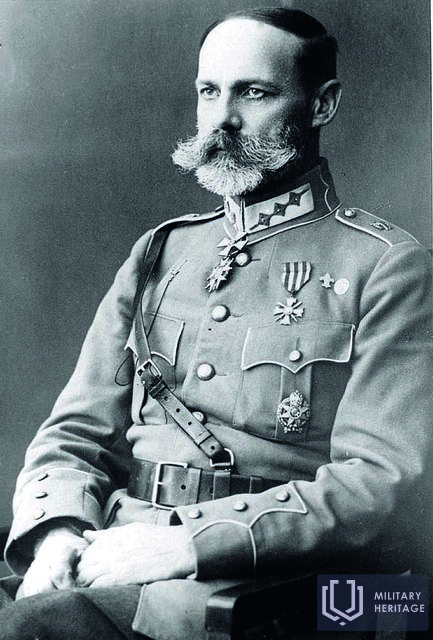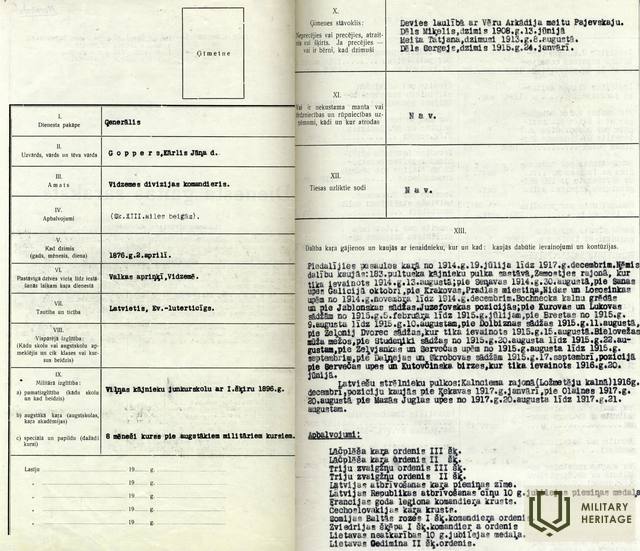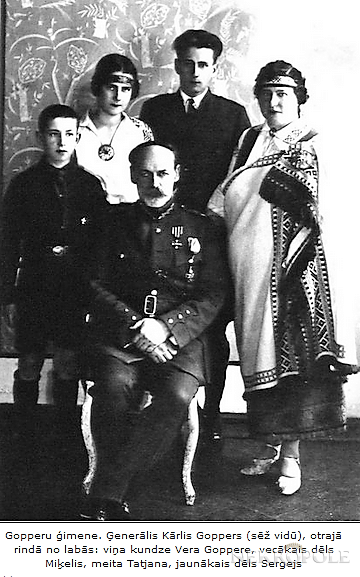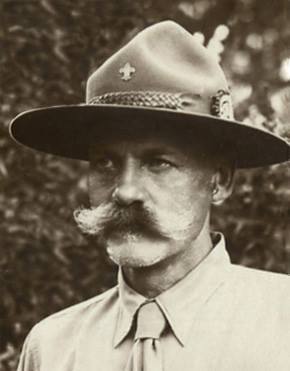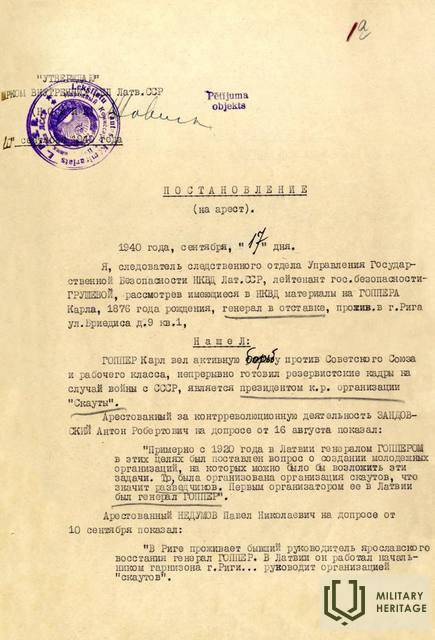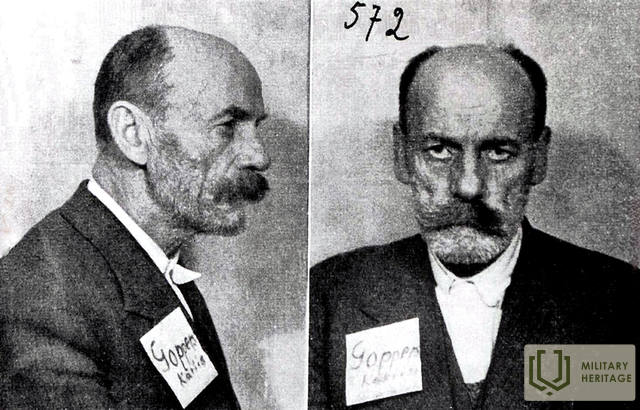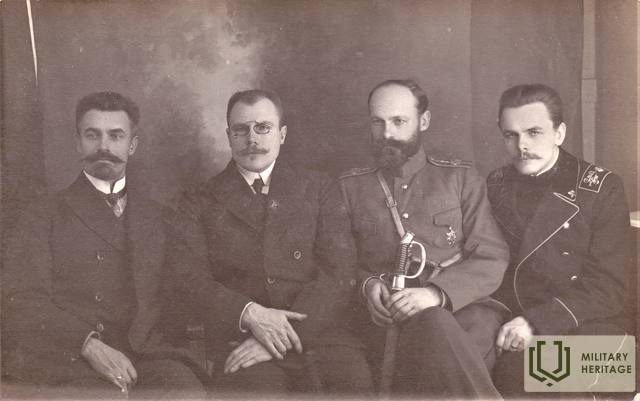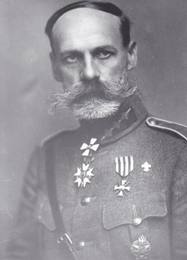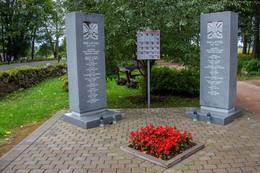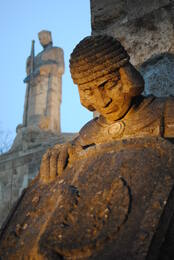Apie generolą Karlį Goppersą
Generolas K. Goppersas (1876–1941) buvo iškilus kareivis ir iškili asmenybė. Jis pasižymėjo kaip sėkmingas vadas, vadovavęs batalionams ir pulkams, didvyriškai vadovavęs savo šauliams kovose už Latvijos laisvę Pirmojo pasaulinio karo (1914–1919 m.) metu. Jis dalyvavo mūšiuose prie Tyreļpurvos, Ložmetējkalno ir ginant Rygą.
Gimė 1876 m. balandžio 2 d. Plāni parapijos „Maskatose“.
Jis mokėsi Trikatos parapijos mokykloje. Baigęs mokyklą, ten ruošėsi barbarų egzaminui, kurį išlaikė, ir tęsė mokslus Pskovo kadetų korpuse.
1893 m. pradėjo tarnybą carinėje armijoje. Pirmojo pasaulinio karo metu buvo sužeistas ir kelis kartus paaukštintas. 1916 m. rugpjūtį, pasveikęs po žaizdos, savo prašymu buvo paskirtas pulkininku leitenantu, Latvijos šaulių rezervinio bataliono vadu, o gruodį – 7-ojo Bauskės latvių šaulių pulko vadu. Nuo 1917 m. – 1-osios Latvijos šaulių brigados vadu. Nuo 1917 m. iki 1920 m. birželio mėn. keliavo po visą Rusiją, kovodamas su bolševikais. 1920 m. rugpjūtį buvo paaukštintas generolu, skaičiuojant nuo 1917 m. rugpjūčio 13 d., nes paaukštinimo patvirtinimas buvo atidėtas dėl Spalio revoliucijos. Grįžęs į tėvynę, vadovavo Latvijos skautų centrinei organizacijai, atitinkamai Saugumo ministerijos, Karo tarybos pirmininku, Senosios Latvijos šaulių asociacijos vadovu ir pulkininko Briežo fondo nariu. Per savo gyvenimą jam buvo įteikta daug Latvijos, Rusijos ir užsienio karinių ordinų.
1940 m. rugsėjo 30 d. K. Goppersas buvo suimtas Rygoje. 1941 m. kovo 25 d. jis buvo sušaudytas Rygos centriniame kalėjime ir palaidotas bendrame kape Ulbroko miške. 1944 m. gegužę K. Goppersas buvo perlaidotas Rygos brolių kapinėse, o jo širdis – 1944 m. gegužės 7 d. Trikatos kapinėse.
1992 m. vasario 11 d. Kārlis Goppers buvo reabilituotas pagal 1990 m. rugpjūčio 3 d. Latvijos Respublikos įstatymą „Dėl neteisėtai represuotų asmenų reabilitacijos“.
Apdovanotas 3-iojo laipsnio Lāčplēsio karo ordinu už tai, kad 1916 m. gruodžio 23 d. naktį, būdamas 2-osios Latvijos šaulių brigados puolimo kolonoje, pirmasis su savo pulku pralaužė vokiečių įtvirtinimų liniją ir įnirtingose kovose giliai priešo užnugaryje pralaužė vokiečių įtvirtinimų liniją, kur taip pat perėmė 8-ojo Valmieros Latvijos šaulių pulko vadovavimą ir 2 dienas išsilaikė, kol gruodžio 25 d. naktį atvyko pastiprinimas, vėliau vadovavo savo daliniams puolime Kalnciemo kryptimi, sukeldamas paniką vokiečių gretose netoli Ložmetējkalno, daugiausia prisidėdamas prie jo užėmimo ir trofėjų įsigijimo, kurių taip reikėjo šauliams, kad papildytų savo skurdų arsenalą.
II klasės Lāčplēsio karo ordinas jam buvo įteiktas už tai, kad 1917 m. rugpjūčio 21 d. Juglos pozicijose, kai 1-oji Latvijos šaulių brigada viena, be artilerijos paramos, turėjo atlaikyti itin aršius puolimus, atrėmė keletą frontalių atakų, sumaniai manevravo su rezervais ir, keisdamas pozicijas iš Mazā Juglos į Lielą Juglą, užkirto kelią apgulčiai ir palengvino mūsų išsilaikymą iki įsakymo išvykti gavimo.
Generolo Karlo Gopperso tarnybos laipsniai :
1893 m. – įstojo į antros klasės eilinį (baigęs vidurinę mokyklą) ir pradėjo tarnauti Kauno tvirtovės pėstininkų batalione.
1894 m. – Vilnijos pėstininkų junkerių mokykloje. Jaunesnysis leitenantas (pirmojo karininko laipsnis).
1896 m. pradėjo tarnybą 97-ajame Vidžemės pėstininkų pulke Daugpilyje, 190-ajame pėstininkų pulke, dislokuotame Varšuvoje (lygiagrečiai tarnybai studijavo filosofiją ir gamtos mokslus).
1900 m. – paaukštintas iki leitenanto (jauniausias karininko laipsnis).
1904 m. – paaukštintas iki štabo kapitono (vyresniojo karininko laipsnis).
1905 m. – tarnavo 183-iajame pulke Pułtuske ir Kostromoje.
1908 m. – paaukštintas iki kapitono (Rusijos imperijos armijoje – hierarchinis laipsnis tarp štabo kapitono ir pulkininko leitenanto).
1912 m. – paskirtas kuopos vadu.
1914 m. jis kovojo Vakarų fronte Galicijoje, Austrijoje-Vengrijoje (dabartinė Ukraina), ir buvo paskirtas bataliono vadu.
Sužeistas tris kartus nuo 1914 iki 1916 m. Po trečiojo sužalojimo evakuotas į ligoninę Maskvoje.
1915 m. – paaukštintas iki pulkininko leitenanto.
1916 m. – paaukštintas pulkininku ir paskirtas Latvijos šaulių rezervinio bataliono vadu, išsiųstas į Valmiermuižą, metų pabaigoje paskirtas 7-ojo Bauskės Latvijos šaulių bataliono vadu.
1917 m. – paskirtas 1-osios Latvijos šaulių brigados vadu, o už kovinius nuopelnus ginant Rygą rugpjūčio 19–21 d. Radko Dmitrijevas rekomenduoja jį paaukštinti iki generolo majoro. Patvirtinta!
Per Rusijos pilietinį karą pulkininko laipsnyje!
Karinės karjeros metu K. Goppersas buvo apdovanotas Latvijos Lačplėsio II ir III klasės karo ordinu, II ir III klasės Trijų žvaigždžių ordinu, Baltosios lelijos skautų ordinu, taip pat keliais aukštais Rusijos, Prancūzijos, Švedijos, Suomijos, Lietuvos, Serbijos ir Čekoslovakijos apdovanojimais.
Apdovanojimai ir pagyrimai :
Rusijos Šv. Stanislavo ordinas, III klasė
Rusijos Šv. Onos ordinas, III klasė
Rusiškas Šv. Jurgio kardas
Šv. Rusijos Stanislavo ordinas, II klasė
Rusijos Šv. Onos ordinas, II klasė
Šv. Jurgio ordinas, IV klasė, Rusija
Šv. Vladimiro ordinas, IV klasė, Rusija
Šv. Vladimiro ordinas, III laipsnis, Rusija
Šv. Jurgio ordinas, III klasė, Rusija
Serbijos Kađorđević žvaigždės, III klasė
Lāčplėsio karo ordinas, III laipsnis
Prancūzijos garbės legiono Komandoro kryžius
Čekoslovakijos karo kryžius
Latvijos išsivadavimo karo memorialas
Suomijos Baltosios Rožės ordino I klasės vadas
Lāčplėsio karo ordinas, II laipsnis
Trijų žvaigždžių ordinas, 3 klasė
Švedijos Ieties ordino Komandoro kryžius, I klasė
Lietuvos Nepriklausomybės 10-ųjų metinių atminimo medalis
Trijų žvaigždžių ordinas, II klasė
Latvijos Respublikos išsivadavimo kovos 10-ųjų metinių atminimo medalis
Lietuvos Gedimino ordinas, II klasė
Latvijos gynybos draugijos bronzos medalis
Latvijos skautų Pilkojo Vilko ordinas
Latvijos skautų Baltosios lelijos ordinas
Latvijos skautų padėkos ženklas „Svastika“
Latvijos skautų „Miško ženklas“
Knygos, leidiniai :
„Keturi griūtys“, 1920 m.
„Karinio lavinimo pagrindai“, 1922 m.
„Krikštatėvis Oskaras“, 1923 m.
„Būkite budrūs“, 1924 m.
„Latvijos šaulių pulko Kalėdos“ 1916, 1924 m.
Tarp dviejų revoliucijų
Prisiminimai apie „šaulių“ erą, 1931 m.
1924–1925 ir 1934–1940 m. – žurnalo „Latvių šauliai“ redaktorius.
Po Antrojo pasaulinio karo, 1947 m. balandžio 20 d., ištremti Latvijos skautai, buvę pabėgėlių stovyklose Vokietijoje, Ansbache įkūrė „Latvijos skautų prezidento generolo Kārlio Gopperso fondą“.
https://www.historia.lv/personas/goppers-karlis
http://skauti.lv/par-mums/vesture/karlis-goppers/
http://www.karamuzejs.lv/lv/Izstades/generali/generalis_GoppersKarlis.aspx
https://www.facebook.com/media/set/?set=a.616149468468565.1073741850.568253149924864&type=3
https://enciklopedija.lv/skirklis/101930-K%C4%81rlis-Goppers
''Generolas Goppers karo ir amžininkų prisiminimuose'', leidykla Zelta Abele, 1951. Švedija
Susijusios temos
Susijusios vietos
Generolo Karlso Gopperso atminimo kambarys jo gimtinėje „Maskati“
Įsikūręs Plani valsčiuje, ant Vijos upės kranto.
Galima aplankyti generolo Kārlio Gopperso atminimo kambarį jo gimtinėje „Maskati“.
„Maskatu“ ūkį valdė generolo brolis Augustas Goppersas, nes talentingas karo vadas buvo užsiėmęs svarbiais įvykiais ir pasauliniais karais. 1920 m. generolas grįžo į Latviją, į gimtuosius namus. Tačiau daugelis atsakingų pareigų jį siejo su Ryga. Augustas toliau vadovavo „Maskatu“. 1940 m. generolas Goppersas buvo suimtas ir 1941 m. kovo 25 d. sušaudytas Čekos rūsiuose. 1944 m. Gopperių šeima su trimis arklių traukiamomis vežimais pabėgo į Kuršą. Karas išskyrė šeimą, o Aleksandro Gopperso dukros – Biruta, Elza ir Ana – liko Latvijoje. Joms nebebuvo leista grįžti į „Maskatu“. Namai buvo dideli ir kruopščiai prižiūrimi. Juose atskiruose kambariuose buvo apgyvendintos trys ar keturios naujokų šeimos. Dideliame tvarte buvo įrengtas arklių ferma. Dėl tarpusavio kivirčų 1980 m. kilo gaisras. Sudegė tvartas ir didelis sandėlis. Laimei, ugnis į namą nepersimetė, liepsnas atbaidė dideli mūsų protėvių sodinti medžiai.
1991 m., po stebuklingo Atgimimo, Latvijos valstybė atgimė antrą kartą. 1992 m. generolo Gopperso brolio Augusto šeima susigrąžino „Maskatus“ kaip savo protėvių šventą vietą. Dešimt metų visi sunkiai dirbo, kad išgelbėtų namus nuo sunaikinimo, atkurtų ir atstatytų sugriautus pastatus, kad visas „Maskatus“ ūkis būtų gražus. Namai buvo atkurti iki senovinės išvaizdos, taip pat įrengtas generolo Kārlio Gopperso atminimo kambarys. Atminimo kambarį galima aplankyti iš anksto paskambinus ir susitarus telefonu +371 29396870, +371 29254285.
Lāčplėsio karinio ordino generolų ir riterių atminimo vietos Trikātos valsčiuje
Atminimo stela yra šalia Trikatos kapinių koplyčios.
Trikātos kapinėse saugomas trijų iškilių Latvijos generolų – Roberto Dambīčio, Kārlio Gopperso ir Jānio Balodžio – atminimas. Trikātos kapinėse palaidotas ir visų šių generolų mokytojas Jēkabs Mūrnieks, kuriam 1928 metais palaidojimo vietoje buvo pastatytas paminklas iš travertino, sukurtas pagal Kārlio Zāle pavyzdį.
Lačplėsio karinio ordino generolai ir riteriai kasmet pagerbiami fakelų procesijomis į Trikatos kapines, kur yra dvi atminimo stelos, kuriose iškalti 17 su Trikatos parapija susijusių Lačplėsio karinio ordino riterių vardai.
Stela buvo atidengta 2018 m. lapkričio 11 d.
Vaizdo įrašas apie Lāčplės karo ordiną ir ordinų rinkinį , priklausiusį generolui Jāniui Balodiui.
Brolių kapinės Rygoje
Rygos brolių kapinės yra šiauriniame Rygos rajone. Kapinės užima 9 ha plotą ir yra iškiliausias bei reikšmingiausias memorialinis ansamblis Latvijoje, skirtas žuvusiems Latvijos kariams. Čia palaidota apie 3000 karių. Brolių kapinės buvo įkurtos Pirmojo pasaulinio karo metu, palaidojus pirmuosius tris Latvijos šaulius, žuvusius Tyrelio purve mūšyje prieš vokiečių armiją. Vėliau Brolių kapinėse taip pat buvo palaidoti Latvijos kariai, žuvę kituose mūšiuose ir karuose. Memorialas sukurtas pagal skulptoriaus Kārlio Zālės projektą ir yra pirmasis memorialinis ansamblis Europoje, turintis tokią kraštovaizdžio, architektūros ir skulptūrinę vertę. Jame naudojami Latvijos kraštovaizdžiui būdingi elementai, tradicinės sodybos, Latvijos folkloras ir istorija, kurie giria karių savybes ir pasakoja apie kario kelią. Memorialas buvo atidengtas 1936 m. ir jį sudaro trys dalys: „Minties kelias“ – 250 m ilgio alėja, „Didvyrių terasa“ su Šventosios liepsnos aukuru ir Šventosios ąžuolyno ansambliu bei laidojimo vieta su Latvijos siena ir motinos su žuvusiais sūnumis memorialu.




